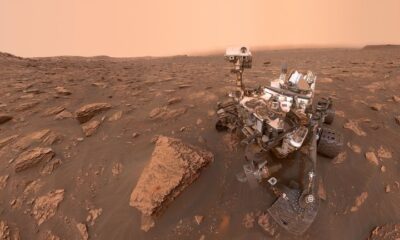Astronomers may have detected the space craft of an alien civilization, claims a top scientist. But the public are being denied further tantalizing discoveries due to the narrow-minded thinking that pervades academia.
In October 2017, an unusually thin, elongated object was detected by astronomers. It was like nothing seen before and even accelerated as it left our solar system. It was named ‘Oumuamua, and its many abnormalities, such as its constantly fluctuating brightness, caused problems for scientists. Indeed, because it did not fit the normal conventions of a space object, one academic admitted to Professor Avi Loeb that they “wished it had never existed”.
But the chair of Harvard University’s astronomy department was excited about the strangeness of ‘Oumuamua, inspired by its anomalies and intrigued by the fact it was the first interstellar object that had been detected passing through our solar system. After studying the data, he announced “the high likelihood that ‘Oumuamua was of artificial origin”.
This caused a sensation in the scientific community, because established thought abhors being “taken out of its comfort zone”, according to Professor Loeb. And now he’s set to antagonize that community further, with the publication of his book on the ‘Oumuamua phenomenon, Extraterrestrial: The First Sign of Intelligent Life Beyond Earth at the end of January.
However, he has a simple response to those who deny potential new breakthroughs for fear of upending established conventions. “Reality is the one thing that never goes away, even if you ignore it,” he says.

‘Shocking’: Leaked PHOTO & classified reports shed light on Pentagon’s UFO-tracking activities
Speaking to RT from his office at Harvard, Professor Loeb is keen to put forward his theory that “we are probably nothing special, and there were many technological civilizations like ours throughout cosmic history”.
For this reason, he argues that there must be a focus on funding for “technological signatures of extra-terrestrial civilizations”. Among the things that could be searched for, he says, are “mega-structures, industrial pollution, and relics of spacecraft”. And it’s the last of these he believes may have drifted through our solar system in October 2017 – a claim that has caused many in the scientific community to close ranks against him.
He suggests there are more such discoveries to come, but many will be denied to us because “people will be ridiculed and ideas never pursued”, describing any consideration of intelligent life beyond earth as being a serious “taboo in the astronomy community”. to the extent that younger scientists even shy away from specific lines of inquiry.
In the case of ‘Oumuamua, there’s no denying that there are perplexing elements. Scientists remain baffled over how it accelerated out of our solar system at an unusual angle. Professor Loeb believes this was due to it being “pushed by sunlight reflecting off its surface” because it was “moving too fast to be bound to the sun”.
He thinks that its abnormal shape acted like “a sail on a boat because, in the vacuum of space, a large, thin object can be accelerated by sunlight”. And he wonders if ‘Oumuamua had an advanced “sun-sail” that an extra-terrestrial civilization could use to travel through space. This outlandish idea was shut down by the academic establishment from the get-go.
So far, the consensus reached to explain the extra push that ‘Oumuamua displayed as it broke free of the sun’s gravitational hold was that it was a comet accelerating due to its melting water vapour, as expelling thrusts a rocket forward. The only problem with this theory – and it’s a glaringly obvious one – is that no tail of water vapour was ever detected coming off ‘Oumuamua.

Mars colonization is ever more likely, but don’t get too excited – it’ll be billionaires deciding who gets there, and how
In September last year, another space object showed acceleration without having a comet-like water vapour tail. Astronomers were again perplexed, and after running the data of its trajectory through a super-computer it was found to be “artificial in construction”. The object was subsequently found to be the empty hull of a discarded rocket booster from earth.
The thin hollow shape was collecting solar rays and being accelerated, just as Professor Loeb had suggested was the cause of ‘Oumuamua’s unconventional movements. This adds to the mystery of ‘Oumuamua. As Professor Loeb explained, “It could not have been of human construction because of the particular way it passed through the solar system, faster than any rocket we could launch.” But he goes on to admit that, to fully validate ‘Oumuamua is of artificial origin, “we need more data”.
This is where that extra funding could come into play. Professor Loeb advises that academia should begin the kind of “blue-sky research” seen in the commercial sector in companies such as Apple, SpaceX, and Amazon. He sees “conservatism in academia”, telling me that projects that tackle alien intelligence rarely get public funding, but rely on investment by interested private individuals. One such initiative is the Breakthrough Listen project at the University of Berkeley’s SETI (Search for Extra-terrestrial Intelligence). Breakthrough Listen is funded by Russian billionaire Yuri Milner, and is the most comprehensive search for alien signals to date.
The mainstream consensus in searching for extra-terrestrial life is to look for signs of oxygen. However, Professor Loeb disputes this, saying it will lead to inconclusive results, “as oxygen could be produced by natural processes”. Instead, he advises searching for industrial pollution on other planets, the rationale being that complex molecules, such as CFCs (chlorofluorocarbons), “cannot be produced naturally”.
As things stand, the debate around ‘Oumuamua continues. Extra-terrestrial life hunters at SETI have supported Professor Loeb’s suggestion there was a possibility that ‘Oumuamua was “an alien artefact.” However, scientists from Queen’s University Belfast have come to the conclusion it was an asteroid.
They told Nature its thin elongated shape is due to it rupturing from a planet in its “violent past”. Professor Alan Fitzsimmons commented: “This was our first close encounter with a large object from another star system and, while we expected to find such an object at some point, the science community is still debating its exact nature.
“We found that we do not need to assume it is artificial as speculated by some; everything we see points to a natural origin. But that doesn’t detract from the wondrous nature of being visited by a piece of another solar system.”
Professor Loeb is steadfast in his belief, though, arguing that discoveries in any branch of science can happen only when people are open-minded and willing to take risks.


 NEWS5 months ago
NEWS5 months ago
 NEWS5 months ago
NEWS5 months ago
 NEWS5 months ago
NEWS5 months ago
 WAR5 months ago
WAR5 months ago
 FINANCE5 months ago
FINANCE5 months ago
 INVESTMENTS5 months ago
INVESTMENTS5 months ago
 FINANCE5 months ago
FINANCE5 months ago



































